Related Research Articles
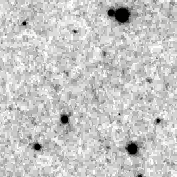
Van Maanen 2, or van Maanen's Star, is the closest known solitary white dwarf to the solar system. It is a dense, compact stellar remnant no longer generating energy and has equivalent to about 68% of the Sun's mass but only 1% of its radius. At a distance of 14.1 light-years it is the third closest of its type of star after Sirius B and Procyon B, in that order. Discovered in 1917 by Dutch–American astronomer Adriaan van Maanen, Van Maanen 2 was the third white dwarf identified, after 40 Eridani B and Sirius B, and the first solitary example.
DENIS J1048−3956 is an exceptionally small, dim ultra-cool red dwarf star about 13.2 light years from Earth in the southern constellation of Antlia, among the closest stars to Earth. This star is very dim with an apparent magnitude of about 17, and will require a telescope with a camera to be seen. It was discovered in 2000 by Xavier Delfosse and Thierry Forveille, with the assistance of nine other astronomers.
LP 145-141 is an isolated white dwarf located 15 light years from the Solar System. According to a 2009 paper, it is the fourth closest known white dwarf to the Sun
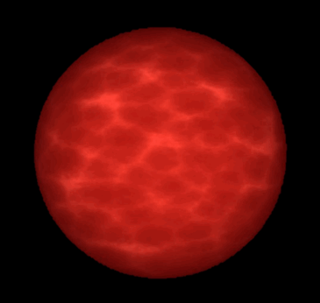
DENIS 0255−4700 is an extremely faint brown dwarf approximately 16 light years from the Solar System in the southern constellation of Eridanus. It is the closest isolated L brown dwarf, and only after the binary Luhman 16. It is also the faintest brown dwarf having measured visible magnitude. A number of nearer T and Y-type dwarfs are known, specifically WISE 0855−0714, Epsilon Indi B and C, SCR 1845-6357 B, DEN 1048−3956, and UGPS 0722−05.
LHS 288 is a red dwarf around 15.8 light years from the Sun, the closest in the constellation Carina. It is far too faint to be seen with the unaided eye, with an apparent magnitude of 13.92.
G 240-72 is a nearby degenerate star of spectral class DQP9.0, located in constellation Draco.
L 97-12 is a nearby degenerate star, located in the constellation Volans, the single known component of the system.

G 99-47 is a nearby degenerate star of spectral class DAP8, the single known component of the system, located in the constellation Orion. G 99-47 is probably the tenth closest white dwarf, followed by Gliese 293, Gliese 518 and Gliese 915.
Wolf 489 is a nearby degenerate star of spectral class DZ10.0), the single known component of the system, located in the constellation Virgo.
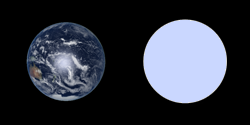
WD 2359-434 is a nearby degenerate star of spectral class DAP5.8, the single known component of the system, located in the constellation Phoenix, the nearest star in this constellation.
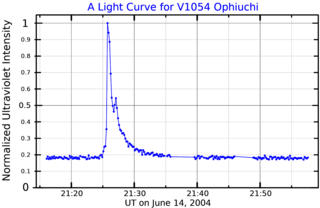
V1054 Ophiuchi, together with the star Gliese 643, is a nearby quintuple star system, in the constellation Ophiuchus at a distance of 21.19 light-years. It consists of five stars, all of which are red dwarfs. The alternative designation of Wolf 630 forms the namesake of a moving group of stars that share a similar motion through space.
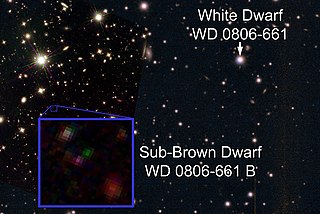
WD 0806−661 is a DQ white dwarf with an extremely cold Y-type substellar companion, located in the constellation Volans at 63 light-years from Earth. The companion was discovered in 2011, and is the only known Y-type companion to a star or stellar remnant. At the time of its discovery WD 0806-661 B had the largest actual and apparent separation of any known planetary-mass object, as well as being the coldest directly imaged substellar object then known.
LHS 2090 is a red dwarf star of spectral type M6.5V, located in constellation Cancer at 20.8 light-years from Earth.
LHS 2520, also known as Gliese 3707, is a red dwarf star in the constellation Corvus. With an apparent magnitude of 12.12, it is too faint to be seen with the unaided eye. A cool star of spectral type M3.5V, it has a surface temperature of 3024 K. The star was too faint to have had its parallax measured by the Hipparcos satellite. Earth-based measurement gives its parallax as 77.93 ± 2.41 milliarcseconds, yielding a distance of 42 ± 1 light-years.
Gliese 318 is a white dwarf in the constellation Pyxis. Its spectral type is DA5.5 and it has a visual magnitude of 11.85, which lies 26 light years away. The star was too faint to have had its parallax measured by the Hipparcos satellite. Earth-based measurement gives its parallax as 113.63 ± 1.97 milliarcseconds, yielding a distance of 28.7 ± 0.5 light-years. It is around 45% as massive as the Sun but has only 0.15% its luminosity.
References
- 1 2 3 4 5 6 "GJ 223.2". SIMBAD . Centre de données astronomiques de Strasbourg . Retrieved 2011-01-17.
- 1 2 3 4 5 6 7 8 9 Holberg, J. B.; Sion, E. M.; Oswalt, T.; McCook, G. P.; Foran, S.; Subasavage, John P. (1 April 2008). "A new look at the local white dwarf population". The Astronomical Journal. 135 (4): 1225–1238. Bibcode:2008AJ....135.1225H. doi: 10.1088/0004-6256/135/4/1225 .
- 1 2 3 4 5 6 7 8 9 Subasavage, John P.; Jao, Wei-Chun; Henry, Todd J.; Bergeron, P.; Dufour, P.; Ianna, Philip A.; Costa, Edgardo; Méndez, René A. (1 June 2009). "The solar neighborhood. XXI. Parallax results from the CTIOPI 0.9 m program: 20 new members of the 25 parsec white dwarf sample". The Astronomical Journal. 137 (6): 4547–4560. arXiv: 0902.0627 . Bibcode:2009AJ....137.4547S. doi:10.1088/0004-6256/137/6/4547. S2CID 14696597.
- 1 2 3 Brown, A. G. A.; et al. (Gaia collaboration) (2021). "Gaia Early Data Release 3: Summary of the contents and survey properties". Astronomy & Astrophysics . 649: A1. arXiv: 2012.01533 . Bibcode:2021A&A...649A...1G. doi: 10.1051/0004-6361/202039657 . S2CID 227254300. (Erratum: doi:10.1051/0004-6361/202039657e). Gaia EDR3 record for this source at VizieR.
- ↑ Sion, Edward M.; Holberg, J. B.; Oswalt, Terry D.; McCook, George P.; Wasatonic, Richard (1 December 2009). "The white dwarfs within 20 parsecs of the Sun: kinematics and statistics". The Astronomical Journal. 138 (6): 1681–1689. arXiv: 0910.1288 . Bibcode:2009AJ....138.1681S. doi:10.1088/0004-6256/138/6/1681. S2CID 119284418.
- 1 2 van Altena, W. F.; Lee, J. T.; Hoffleit, E. D. (1995). The General Catalogue of Trigonometric [Stellar] Parallaxes (4th ed.). New Haven, CT: Yale University Observatory. Bibcode:1995gcts.book.....V. VizieR entry.
- ↑ Table 1 in Sion et al. 2009
- ↑ Costa, Edgardo; Méndez, René A.; Jao, W.-C.; Henry, Todd J.; Subasavage, John P.; Brown, Misty A.; Ianna, Philip A.; Bartlett, Jennifer (July 2005). "The solar neighborhood. XIV. Parallaxes from the Cerro Tololo Inter-American Observatory Parallax Investigation—First results from the 1.5 m telescope program". The Astronomical Journal. 130 (1): 337–349. Bibcode:2005AJ....130..337C. doi: 10.1086/430473 .